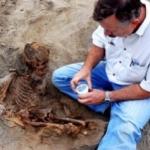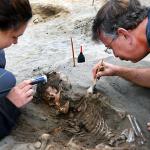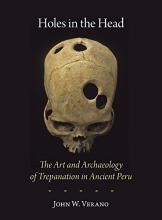John Verano
Professor

Biography
Professor Verano received his B.A. with Distinction in anthropology from Stanford University in 1977, and his M.A. (1980) and Ph.D. in anthropology from the University of California Los Angeles in 1987. He is a biological anthropologist who specializes in human skeletal anatomy, paleopathology, bioarchaeology, and forensic anthropology. His primary research area is Andean South America, with a focus on prehistoric populations of coastal and highland Peru. Specific research interests include pathology in ancient skeletal and mummified remains, trepanation and other ancient surgery, warfare, human sacrifice, and mortuary practices. In addition to his South American research, Professor Verano provides consultation in forensic anthropology, assisting local, state, and federal law enforcement, coroners, and medical examiners in recovering, identifying and interpreting human skeletal remains from medico-legal contexts.
Education
University of California Los Angeles
University of California Los Angeles
Stanford University
Accomplishments
Performance Award
1993
National Museum of Natural History, Smithsonian Institution
Links
Articles
Looking back, looking forward: Paleopathology in Andean South America
Over the past twenty years, the field of Andean paleopathology has advanced significantly thanks to a new generation of scholars who have been attracted to this region and whose innovative research has expanded our knowledge substantially. The papers in this special issue demonstrate how the field of Andean paleopathology has diversified and grown to become what is today a truly interdisciplinary enterprise involving archaeology, ethnohistory, biological anthropology, geochemistry, medical imaging, and genetics. These studies apply theoretical approaches to research questions that are increasingly innovative and nuanced as well as analytical methods that were in their infancy when I wrote my 1997 survey of the field.
A mass sacrifice of children and camelids at the Huanchaquito-Las Llamas site, Moche Valley, Peru
Here we report the results of excavation and interdisciplinary study of the largest child and camelid sacrifice known from the New World. Stratigraphy, associated artifacts, and radiocarbon dating indicate that it was a single mass killing of more than 140 children and over 200 camelids directed by the Chimú state, c. AD 1450. Preliminary DNA analysis indicates that both boys and girls were chosen for sacrifice. Variability in forms of cranial modification (head shaping) and stable isotope analysis of carbon and nitrogen suggest that the children were a heterogeneous sample drawn from multiple regions and ethnic groups throughout the Chimú state. The Huanchaquito-Las Llamas mass sacrifice opens a new window on a previously unknown sacrificial ritual from fifteenth century northern coastal Peru. While the motivation for such a massive sacrifice is a subject for further research, there is archaeological evidence that it was associated with a climatic event (heavy rainfall and flooding) that could have impacted the economic, political and ideological stability of one of the most powerful states in the New World during the fifteenth century A.D.
Camelid Gastrointestinal Parasites from the Archaeological Site of Huanchaquito (Peru): First Results
Palaeoparasitological investigation was conducted on a first set of samples from 13 sacrificed domestic camelids recovered from the pre-Hispanic Chimú culture site of Huanchaquito-Las Llamas, Peru. The aim was to establish the animals’ gastrointestinal parasite diversity and enlighten on their health status at the time of their death. To this end, 20 samples of coprolites and intestinal contents were analysed to check for the presence of parasite markers, i.e. preserved eggs and oocysts. Microscopic examinations revealed the presence of five taxa of helminths and protozoans in a majority of the tested animals (61%). Our analysis revealed the presence in some animals of protozoan oocysts belonging to the species Eimeria macusaniensis (phylum Apicomplexa). Our study is the first report of the possible presence of a parasite egg attributed to the order Plagiorchiida (family Fasciolidae) in ancient camelids. This preliminary study shows that there is interesting potential for conducting palaeoparasitological analysis at the site and that such analysis is promising for answering questions about the health status of the Huanchaquito-Las Llamas camelids.
Herds for the Gods? Selection Criteria and Herd Management at the Mass Sacrifice Site of Huanchaquito-Las Llamas During the Chimú Period, Northern Coast of Peru
The discovery of the sacrificial remains of 140 children and 206 camelids sacrificed at the site of Huanchaquito-Las Llamas, on the northern coast of Peru, has provided new data on mass sacrifice practices during the Chimú period. The exceptional state of preservation of the camelids, including the presence of coats and hides, opens new research perspectives on the utilisation of animals in ritual contexts. This article will focus on the results of the zooarchaeological analysis, particularly of mortality profiles and coat colour, to address the criteria used to select the sacrificial victims. Young individuals were exclusively selected, and while there is a majority of brown coats, three colours that are present in modern herds are absent at Huanchaquito. This reveals the preferential choice made by the Chimú officiants for this sacrifice. A spatial analysis did not reveal preferences in the organisation of the deposits. The killing of the youngest cohort of the livestock probably had an impact on the whole livestock. This suggests the existence of large herds that were controlled by the Chimú empire. Our results provide additional insights into the management of camelid herds and show the complexity of pastoralism on the pacific coast during pre-Hispanic times.
Life History and Origin of the Camelids Provisioning a Mass Killing Sacrifice During the Chimú Period: Insight from Stable Isotopes
The site of Huanchaquito-Las Llamas, situated in the Moche Valley, Peru, dated to the Late Intermediate Period (AD 1100-1470), represents a single event mass killing of children and domestic camelids of the Chimu society. Reconstruction of the life histories of 82 camelid individuals based on stable isotope analysis of bone collagen indicates that they originated from the lowlands. Isotopic inter-individual variability indicates diversity in dietary sources, consisting of wild plants and cultigens, grown in water-limited and non-water-limited conditions, as well as a large proportion of C4 plants, suggesting that the animals originated from various herds that were differently managed. In contrast, uniformity in terms of restricted coat colour and young age could suggest that the animals derived from specialised herds. It is possible that the requirement in a short period of time for a massive number of animals meeting certain criteria exceeded the capacity of these herds. This study presents the largest isotopic dataset measured at a single pre-Hispanic site so far and the first to record herding practices for the Chimú society. Comparison with previous isotopic datasets shows differences between ritual and non-ritual groups, as well as diversity in pastoralism practises through time in the Central Andes.
Media Appearances
Massacre of Children in Peru Might Have Been a Sacrifice to Stop Bad Weather
“What we seem to have at Huanchaquito-Las Llamas is a sacrifice to stop torrential rains, flooding and mudflows,” said John Verano, an anthropologist at Tulane University and an author of the paper, which was published Wednesday in PLOS One.
What made this ancient society sacrifice its own children?
To help make sense of the clues, Prieto called John Verano, a biological anthropologist and forensic expert at Tulane University. Verano has decades of experience analyzing physical evidence of ritual violence in the Andes, including a 13th-century Chimú massacre of some 200 men and boys at the site of Punta Lobos.
Exclusive: Ancient Mass Child Sacrifice May Be World's Largest
Scientific investigations by the international, interdisciplinary team, led by Gabriel Prieto of the Universidad Nacional de Trujillo and John Verano of Tulane University, are ongoing. The work is supported by grants from the National Geographic Society.
Were mystery holes in skulls an ancient aspirin?
John Verano investigates ancient mysteries. As a forensic anthropologist, he's examined skeletons and mummies throughout the Americas to unlock secrets about prehistoric human sacrifice, warfare, injury and disease.
Peruvian dig reveals sacrificial mystery
Tulane University physical anthropologist John Verano has spent summers in Peru for the last 30 years, digging for ancient bones and solving their secrets. But his most recent work focuses on a unique archeological discovery: a ritual sacrifice of children and young llamas dating back 600 years.
Tulane Today Mentions
New study reveals a long history of violence in ancient hunter-gatherer societies
Tulane professor’s work at “unthinkable sacrifice” site published in major journal
Tulane experts tackle tough topics
Archaeological sciences course gears up for big year
1,700-year-old mummy faces future with new look
‘CSI’ skills are focus of summer course
New textbook explores ancient cranial procedure
In the News
Medium: Drilling A Hole In Your Head to Treat a Headache
CNN: Were mystery holes in skulls an ancient aspirin?
Science: South America’s Inca civilization was better at skull surgery than Civil War doctors
Smithsonian: Drilling Deep: How ancient Chinese surgeons opened skulls and minds
National Geographic: Amazing things we’ve learned from 800 ancient skull surgeries
Smithsonian: Inca Skull Surgeons Had Better Success Rates Than American Civil War Doctors
TeleSUR: 3D Technology Brings Peru Empress to Life After 1700 Years
FOX 59: Why do ancient skulls have holes cut into them? Researcher thinks it was headache cure






